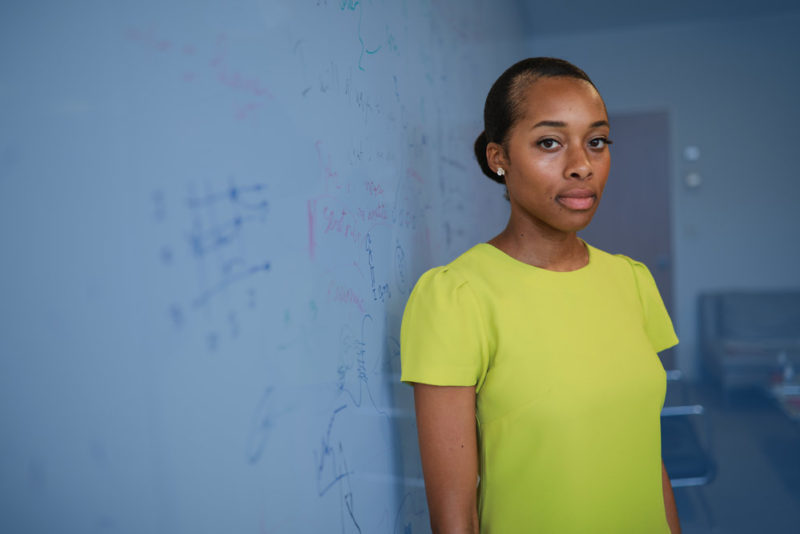A neuroscientist and postdoctoral researcher at Columbia’s Zuckerman Institute, Bianca Jones Marlin has investigated topics from how the brain adapts to care for a newborn to transgenerational epigenetic inheritance. Her fascinating research – like the role of oxytocin in motherhood – has been published in scientific journals and picked up by National Geographic, Discover Magazine and The Guardian. I spoke with Bianca ahead of her talk this Friday night on The Science of Love, about her research on oxytocin and intergenerational trauma…
Tell me about your research on the role of oxytocin in motherhood.
Oxytocin – known as the “love drug” – is naturally released in humans through skin-on-skin contact through soft touching, breastfeeding or having an orgasm but also through non-direct contact like when you’re exchanging eye contact with someone.
In mice, which is what I study in my lab, oxytocin can be released through social contact like living with and learning from other mice.
And my research focused on a specific species of female mice that’s known for being the “worst” mothers! When they hear the cries of young mice pups, they either ignored them or cannibalized them. But when oxytocin is added to the left side of the auditory cortex of these “virgin” mice, it changes the way the neurons fire in their brains and their behavior changed.
We used a drug called muscimol which silences neurons in a particular area wherever you’ve added it. We added it to the left auditory cortex, the brain’s hearing center.
It was amazing to see that the neural responses to the pups were lateralized! The virgin mice went from wanting to eat the pups to wanting to retrieve and take care of them.
What about fathers? Were male mice better fathers if given a dose of oxytocin?
Mice are non-monogamous and the females are the primary caregivers, nursing their pups for 21 days.
While male mice do have oxytocin receptors and we did see retrieval behavior at a faster rate when given the oxytocin dosage, it wasn’t fast enough to ensure the survival of the pup in the wild.
In the wild, pup retrieval is an essential behavior for moms who are nursing. Their pups are attached to her for the first few weeks of their life and so when the mom needs to move and the pup falls off, that’s when she really needs to find it and pick it up quickly to make sure the pup doesn’t die.
With oxytocin, female mice learn to retrieve their pup in 12 hours, while the males need 3-5 days. That’s too long for the pup to survive on its own.
Did your research use naturally produced oxytocin or artificially produced oxytocin (Pitocin)?
We wanted to use endogenous oxytocin, as opposed to the synthetic kind, Pitocin, which is what you’re given when you’re being induced for labor, for example.
We applied a technique called optogenetics that uses light to shine on neurons that respond to oxytocin. We changed the genetics of the mice so that blue light would activate the natural release of oxytocin, with the added DNA from sea algae.
You also study the heritability of trauma. Are you looking at oxytocin as a treatment to strengthen broken parent-child relationships?
We know oxytocin can induce these important social behaviors but, as much as you want to take things from the lab bench to the hospital, we need to understand how things work on a molecular level first. My goal is to inform doctors of medicine how oxytocin works and the mechanisms behind transgenerational epigenetics of trauma. It’s up to the MDs to see what can be done next and the ramifications of applying these drugs.
It’s not my goal to create drugs but, rather, to be well informed before we even go into pharmaceuticals.
What are you researching next?
I’ll be starting my laboratory at Columbia soon and my end goal is how science can inform society. In order to do that, we need to understand the intergenerational effects of trauma, how it changes the brain, and future families.
I’ll be looking at how the environment dictates our behavior and neuroplasticity but also how there are things we can do to change the outcomes of childhood trauma, like providing a safe, loving home.
My current research shows that traumatic events experienced by fathers have lasting effects that can be passed on to their kids. But, before we look at stopping this, we need to figure out exactly what’s happening to the traumatized brain. That’s my immediate goal.
Meet Bianca Jones Marlin, PhD, at the Simons Foundation on Friday February 28th, for a talk on The Science of Love. Details here.


